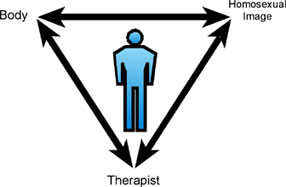by Joseph Nicolosi, Ph.D.
This is the paradox of Reparative Therapy®: it is successful only if the client first faces and accepts his unwanted feelings.
The more the person sees the thing inside himself that he rejects, and sees it in the light of truth, the more it dissipates. The task is not to look away from the feelings, but to look through them.
When we use the "Triangle of Containment" in therapy, the client is asked to focus directly on a homosexual thought or fantasy. At the same time, he should actively attend to his bodily sensations. While doing this, he is asked to stay connected to the therapist. When the client is holding on to the homoerotic image, he will usually experience a simultaneous bodily arousal. (Some men describe it as a genital surge, a rush or a "zap.") If he can accept his bodily homoerotic experience while staying connected to the therapist, the sexual feeling soon transforms into something else: the recognition of deeper, pain-generated emotional needs which have nothing to do with sexuality.
Re-experiencing the feelings in the presence of an accepting therapist helps remove that shame; the client is then better able to see his same-sex desire for what it is. One man described his liberation from shame by looking deeper the homoerotic illusion. "Looking at it in the light of day," he said, "takes the 'leprosy' out of it."
When we push the shame aside--facing the feared fantasies directly--we see the true nature of the man’s homoerotic attraction, which is about attachment loss. When the man looks past that erotically charged male symbol -the icon of a missing part of his identity—he can begin to fulfill the same-sex attachment needs that are truly at the core of his deepest longings.


